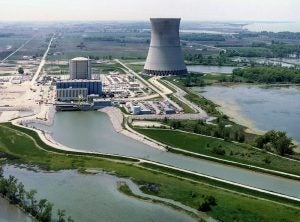 Since it was first filed in the Ohio legislature, HB 6 has been pitched as a necessary savior for a struggling Ohio utility and employer. FirstEnergy Solutions’ nuclear plants are losing money, the sales pitch goes, and the publicly-traded company needs $150 million a year by June 30 or it will shut down the plants and Ohio will lose 4,000 jobs.
Since it was first filed in the Ohio legislature, HB 6 has been pitched as a necessary savior for a struggling Ohio utility and employer. FirstEnergy Solutions’ nuclear plants are losing money, the sales pitch goes, and the publicly-traded company needs $150 million a year by June 30 or it will shut down the plants and Ohio will lose 4,000 jobs.
Let me suggest that everything about this is wrong.
The June 30 deadline was wrong
We know now that the June 30 deadline was wrong because, well, it’s after June 30. When the deadline passed, FirstEnergy told reporters that it will proceed with taking steps to shut down the plants, but it can reverse course at a later date. Perhaps FirstEnergy’s leadership knew it was a false deadline, like the many other times the company cried wolf.
The 4,000 jobs is wrong
In his June 11 testimony, Ohio Rep. Jamie Callendar said that 4,000 jobs were at risk. FirstEnergy’s Lindsay Humble put the number at 4,300 jobs. Yet Charles Moore, the FirstEnergy restructuring manager for the bankruptcy reorganization, testified that the entire FirstEnergy Solutions company employs 2,700 persons, which includes operations unrelated to the nuclear plants, such as their retail marketing business. FirstEnergy Solutions has published fact sheets showing that Davis-Bessie has 720 employees and Perry has 760 employees — a total of 1,480 employees at the nuclear plants.
Even if we’re generous with the number — let’s say 2,200 jobs — a $150 million per year bailout is a bad investment of taxpayer money.
FirstEnergy’s bailout campaign is filled with all kinds of wrong. Please let a failed HB 6 be the end of it. Share on XThe legislature would be much better off giving the funding to JobsOhio, the non-profit corporation that uses state liquor funds to do economic development in Ohio. According to a McKinsey analysis of JobsOhio’s track record, the corporation paid out $1 billion in economic development incentives between 2013 and 2017 that created or retained a total of about 154,000 jobs – an average of $6,500 in incentives per job. That would be a much better use of taxpayer money than a free handout to FirstEnergy Solutions.
Giving taxpayer money to a profitable, publicly traded company is wrong
HB 6 is a $150 million handout to FirstEnergy Solutions to keep its two nuclear plants open. Why should FirstEnergy Solutions receive any free handouts? In his June 29 testimony, Michael Haugh of the Ohio Consumers’ Counsel showed that the two nuclear units earned a combined profit of $50 million since the company filed for bankruptcy.
FirstEnergy Solutions’ ongoing bankruptcy case will likely discharge all of the company’s debt, which will make it even more profitable in the future. The company recently gave the Bankruptcy Court a financial projection for the five-year period of 2019-2023, showing expected earnings before taxes, depreciation and amortization of nearly $1 billion. Does a business that earned $50 million in profits last year and expects $1 billion in earnings over 5 years deserve a free handout of $150 million per year?
The $150 million per year is wrong
The $150 million per year that FirstEnergy claims it needs to keep the nuclear plants open is wrong. More to the point, FirstEnergy’s financial projections regarding the nuclear plants have always been wrong. When FirstEnergy initially requested a bailout at the PUCO in 2014, it claimed the plants would provide an annual profit of $107 million beginning in 2019, that the plants would continue to be profitable through 2031, and that the plants would have a net profit of $2 billion through 2031.
In February 2016, FirstEnergy claimed the plants would generate a net profit of $561 million from 2016 to 2024. Five months later, FirstEnergy changed course and asked for an annual $561 million subsidy for eight years. Then, in June 2016 testimony, FirstEnergy stated that it needed an annual subsidy of $150 million. Like the artificial, June 30, 2019, shutdown deadline, FirstEnergy has been all over the map regarding the plants’ financial performance and the amount of a bailout needed.
Dr. Paul M. Sotkiewicz of E-Cubed filed testimony last month on behalf of the American Petroleum Institute stating that, over the next 10 years, Davis-Besse is expected to earn $280 million and Perry is expected to earn $440 million. He based his opinion on a detailed analysis of all of the costs (fuel costs, capital costs and O&M) and the projected wholesale energy market prices, and he provided the sources for all of his data, which he submitted for this Committee’s review and inspection.
On the other hand, FirstEnergy submitted the testimony of Charles Moore, who is managing the FirstEnergy Solutions restructuring process. Moore said the plants needed $150 million/year to remain open, but he did not submit any proof or data to back up his opinion.
Who should Ohioans believe, Dr. Sotkiewicz’s well-reasoned analysis, or Mr. Moore’s unsupported, paid opinion?
Just like so much of FirstEnergy’s bailout campaign, HB 6 is wrong.
HB 6 is not a fix for any real Ohio problem. It’s not a critical job saver. It won’t keep the state’s electric grid from crumbling. And it won’t “clean the air,” as the bill’s Orwellian name suggests it would.
Just like so many threats, statistics and dates FirstEnergy has promoted in pursuit of its billion dollar bailout, HB 6 is wrong.
As Harry Truman said: “The buck stops here.” Let’s hope that FirstEnergy’s bailout campaign will finally stop with the failure of HB 6.









